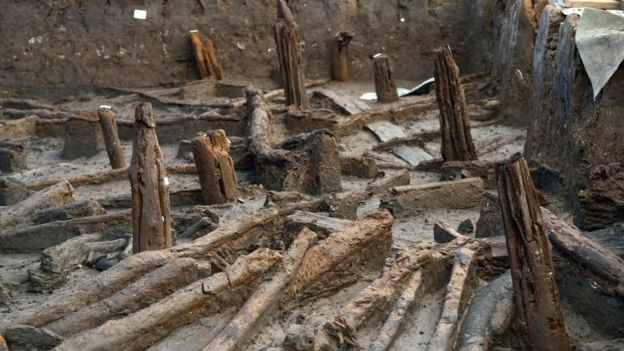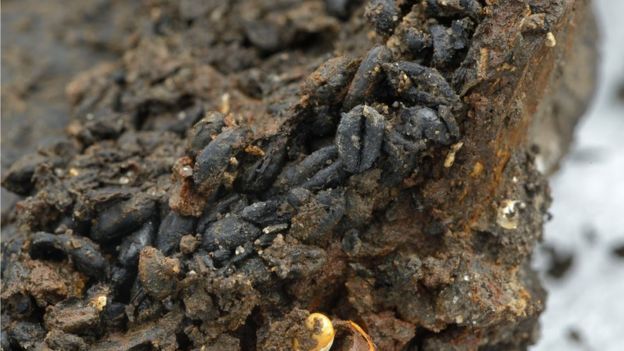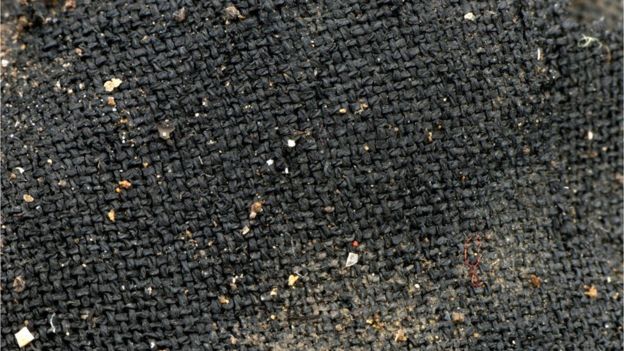An ancient village dubbed "Britain's Pompeii" was just a few months old when it burnt down, it has emerged.
Analysis of wood used to build the settlement suggests it was only lived in for a short time before it was destroyed.
Despite this, archaeologists said the site gives an "exquisitely detailed" insight into everyday Bronze Age life.
Evidence of fine fabric-making, varied diets and vast trading networks has been found during the 10-month dig.
The level of preservation at the site, in Whittlesey, Cambridgeshire, has been compared to that seen at Pompeii, a Roman city buried by ash when Vesuvius erupted in AD 79.
Media captio Image copyrightCAMBRIDGE ARCHAEOLOGICAL UNITImage captionThe stilts that held the houses can be seen, together with collapsed roof timbers
Image copyrightCAMBRIDGE ARCHAEOLOGICAL UNITImage captionThe stilts that held the houses can be seen, together with collapsed roof timbers
At least five circular houses raised on stilts above the East Anglian fens have been found.
David Gibson, of the Cambridge Archaeological Unit, University of Cambridge, said the site allowed researchers to "visit in exquisite detail everyday life in the Bronze Age".
"Domestic activity within structures is demonstrated from clothing to household objects, to furniture and diet," he said.
"These dwellings have it all, the complete set, it's a 'full house'.

 Image copyrightCAMBRIDGE ARCHAOLOGICAL UNIT
Image copyrightCAMBRIDGE ARCHAOLOGICAL UNIT
'Pompeii of the Fens'
What the excavation reveals:
- The people living here made their own high quality textiles, like linen. Some of the woven linen fabrics are made with threads as thin as the diameter of a coarse human hair and are among the finest Bronze Age examples found in Europe
- Other fabrics and fibres found include balls of thread, twining, bundles of plant fibres and loom weights which were used to weave threads together. Textiles were common in the Bronze Age but it is very rare for them to survive today
- Animal remains suggest they ate a diet of wild boar, red deer, calves, lambs and freshwater fish such as pike. The charred remains of porridge type foods, emmer wheat and barley grains have been found preserved in amazing detail, sometimes still inside the bowls they were served in
- There were areas in each home for storing meat and a separate area for cooking
- Even 3,000 years ago people seemed to have a lot of stuff. Each of the houses was fully equipped with pots of different sizes, wooden buckets and platters, metal tools, saddle querns (stone tools for grinding grains), weapons, textiles, loom weights and glass beads

After the fire, the buildings sank into a river which has helped preserve them.
 Image copyrightCAMBRIDGE ARCHAEOLOGICAL UNITImage captionThe charred remains of porridge type foods, emmer wheat and barley grains have been found preserved in amazing detail, sometimes still inside the bowls they were served in
Image copyrightCAMBRIDGE ARCHAEOLOGICAL UNITImage captionThe charred remains of porridge type foods, emmer wheat and barley grains have been found preserved in amazing detail, sometimes still inside the bowls they were served in Image copyrightCAMBRIDGE ARCHAEOLOGICAL UNITImage captionThe tip of a spear
Image copyrightCAMBRIDGE ARCHAEOLOGICAL UNITImage captionThe tip of a spear
Evidence, including tree-ring analysis of the oak structures, has suggested the circular houses were still new and had only been lived in for a few months.
The homes were, however, well equipped with pots of different sizes, wooden buckets and platters, metal tools, saddle querns (stone tools for grinding grains), weapons, textiles, loom weights and glass beads.
Archaeologists say beads found at the site originally came from the Mediterranean or Middle East.
 Image copyrightCAMBRIDGE ARCHAEOLOGICAL UNITImage captionAn example of the types of fabric found at Whittlesey
Image copyrightCAMBRIDGE ARCHAEOLOGICAL UNITImage captionAn example of the types of fabric found at Whittlesey
Duncan Wilson, chief executive of Historic England, said: "This has transformed our knowledge of Bronze Age Britain.
"Over the past 10 months, Must Farm has given us an extraordinary window into how people lived 3,000 years ago.
"Now we know what this small but wealthy Bronze Age community ate, how they made their homes and where they traded.
"Archaeologists and scientists around the world are learning from Must Farm and it's already challenged a number of longstanding perceptions."
Must Farm was named best discovery at the 2016 British Archaeological Awards.

